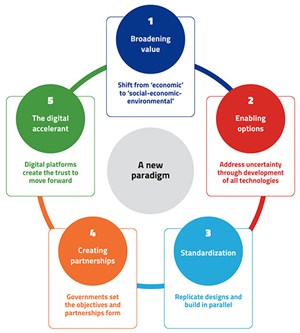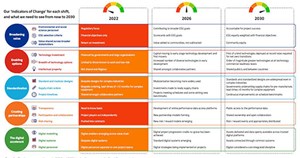Articles
From ambition to reality: Measuring change in the race to deliver net zero
Carbon Capture/CO2 Mitigation
P. EBERT, Worley, London, UK; C. GREIG, Princeton University, Princeton, New Jersey; and C. ANDERSON, Worley, Melbourne, Australia
Worley and Princeton University’s Andlinger Center for Energy and the Environment are exploring what it will take to move the world to net-zero by mid-century. The required infrastructure has been studied and it has been determined that the necessary speed and scale of development are unprecedented. Continuing to develop and build infrastructure the way we now do will be insufficient—a complete reimagining of infrastructure delivery is required.
The global community must make systemic changes to the way it shares value, develops technologies, standardizes designs, creates partnerships, collaborates, and embraces digital tools and thinking. In short, a radical but durable new paradigm for infrastructure delivery must be established that will provide the foundation to move confidently towards net-zero by mid-century.
This article, a Part 2 of Worley and Princeton University’s “From Ambition to Reality” paper, offers a deeper dive into the five key shifts described in the first paper (FIG. 1).1 Examples are explored from a range of sectors where new implementation approaches have had a transformational impact, from reducing vaccine development time from 10 yr to 1 yr through parallel development and partnerships, to being able to assemble a bridge in a week by leveraging modular design.
Worley and Princeton University propose 15 leading indicators of change, three per shift, that will allow operators and companies to measure, adjust and correct infrastructure delivery practices to meet the challenge of scale and speed (FIG. 2). An outline is offered for how performance against these indicators must progress over time, starting from an assessment of where industry is now, where we need to be by 2026, and where we ultimately must be by 2030, which is a pivotal target year if industry is to have any chance of reaching net-zero by 2050.
Success by 2030 looks like:
- Broadening value: Projects deliver more than financial value with communities at the heart of the transition.
- Enabling options: Existing low-carbon technologies are being deployed and there is investment in the future technologies needed. Intellectual property is shared openly.
- Standardization: Engineers are working to agreed global standards, with designs based on equipment and modules already available in the supply chain.
- Creating partnerships: Partnerships broaden and collaboration becomes the norm. The public has full visibility of projects, operating assets and performance.
- The digital accelerant: Secure digital platforms connect all stakeholders and assets. Project data is openly shared, with teams learning from each other.
Today, the overall gap between current project delivery practices and 2030 targets is assessed as high. A significant amount of work remains to close the gap on all five shifts by 2030.
To help close this gap, Worley and Princeton University’s work to turn ambition into reality will be informed by an independent annual global survey outlined in the report. Undertaken by Princeton University, the survey will track these indicators of change, year-on-year (y-o-y) from 2023–2030, across 10 core stakeholder groups (including asset owners, project developers, regulators, communities, service providers, educators and policy makers) that are influential in the delivery of infrastructure. The “Ambition to Reality Survey” seeks to establish a panel of more than 3,000 individuals across multiple regions. The results will be used to determine if and where the global infrastructure build is on track and, if not, where it is not and how course corrections might be made.
Finally, reinforcing the extent of the challenge, a new set of net-zero numbers is discussed, this time for a very different economy than the U.S. (examined in the first paper) using data from Net Zero Australia. Australia is a much smaller energy economy—but with greater energy exports—and its numbers are just as daunting. The country requires up to 3,000 GW of new renewables by 2050, essentially replicating the total world renewable current fleet, and up to 1 Gt of carbon dioxide (CO2) sequestration. Despite the differences between the nations, the scale of the challenge is similar.
To achieve such numbers, the message is clear: industry must dramatically rethink the way infrastructure is delivered. Authentic environmental, social and governance (ESG)-charged partnerships, standardized design, reliable supply chains, fully immersed communities, a digital overhaul, honesty, transparency and a collective imperative: that’s how we’ll get to net zero by mid-century.H2T
LITERATURE CITED
1 Worley, “Measuring change in the race to deliver net zero,” online: Measuring change in the race to net zero – Worley
About the author

PAUL EBERT is the Group Director, Sustainability and Energy Transition Leadership, for Worley. Dr. Ebert has more than three decades experience working in clean energy and his roles have included responsibility for projects across a wide range of technologies and industries. This has included enablers such as distributed energy, green hydrogen, various forms of energy storage and their integration into industrial processes and markets. Dr. Ebert is a mechanical engineer with a PhD in wind turbine aerodynamics. He sits on the Advisory Panel for Net Zero Australia and is a former advisory or steering committee member for CSIRO, Australian National University and the University of Newcastle.

CHRIS GREIG is the Theodora D. and William H. Walton III Senior Research Scientist at Princeton University’s Andlinger Center for Energy and the Environment. He holds a PhD in chemical engineering, is a fellow of the Australian Academy of Technology and Engineering (ATSE) and holds an adjunct professorial appointment at the University of Queensland in Australia. Dr. Greig’s academic career follows almost three decades of international experience in the private sector, first as a company founder and then in senior executive and non-executive director roles in major engineering, energy and resources companies.

CLARE ANDERSON is the Director of Sustainability Performance for Worley and is passionate about the decarbonization of the energy, chemical and resources industries. Dr. Anderson earned a PhD in chemical engineering, specifically relating to the adaptation of low-carbon technologies, and has delivered major energy infrastructure projects in Europe, South Africa and Australia. She is a former Director of the Australian Institute of Energy and now sits on the advisory panel for Net Zero Australia.



